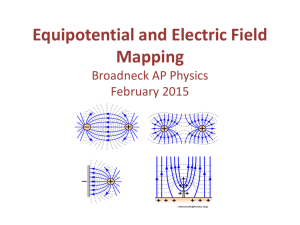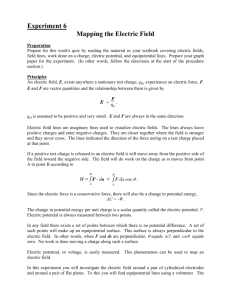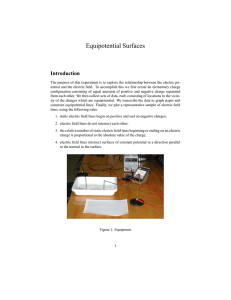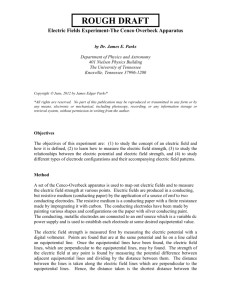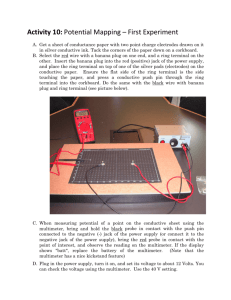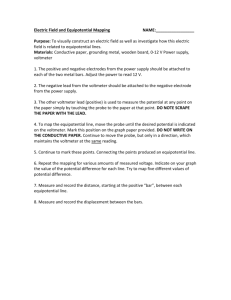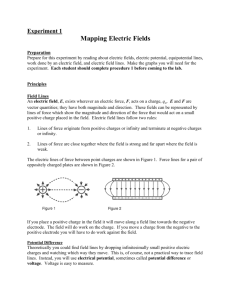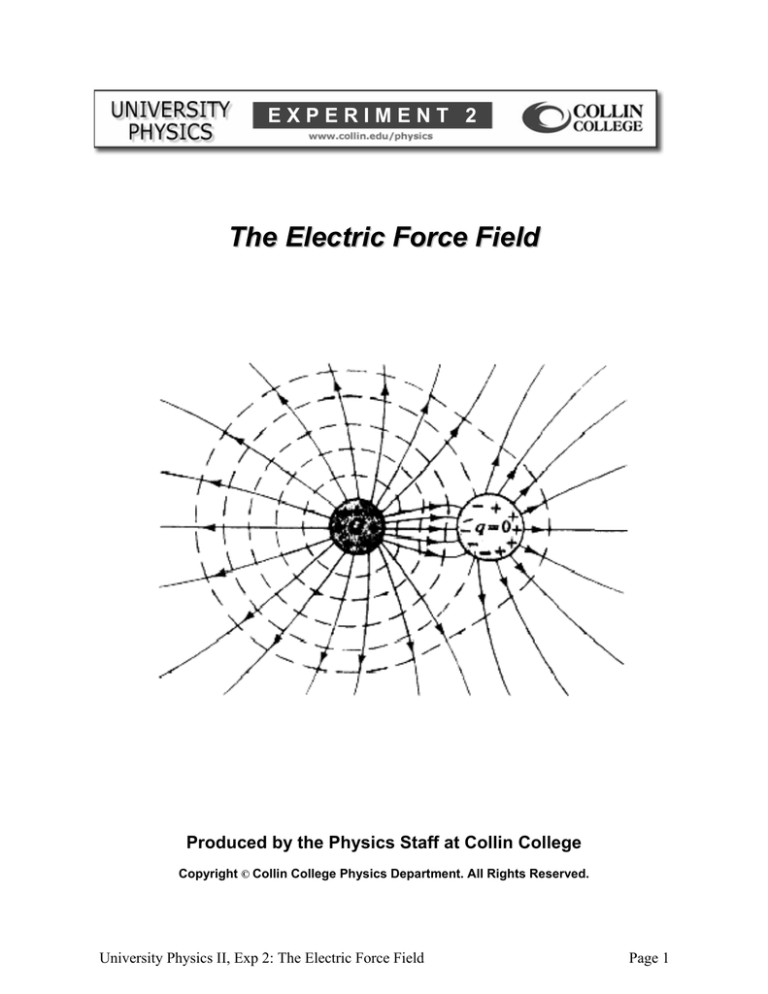
EXPERIMENT 2
The Electric Force Field
Produced by the Physics Staff at Collin College
Copyright © Collin College Physics Department. All Rights Reserved.
University Physics II, Exp 2: The Electric Force Field
Page 1
Purpose
In this experiment you will investigate the electric force field.
Equipment
•
•
•
•
1 Pasco Field Mapper Set
2 sheets conductive paper
4 push pins
1 Voltmeter
•
•
•
•
1 Overbeck Field Mapper
4 long clip leads
1 0-15 V Power Supply
1 Galvanometer
Introduction
Coulomb’s law is the relationship between the magnitude of the electric force F, two point
charges Q1 and Q2, and the distance d between them:
QQ
F = k 122
Equation 2.1
d
9
2 2
with the constant of proportionality k = 9.0 × 10 Nm /C . You can infer the direction of the
vector F from the law of charges, which states that like charges repel and unlike charges
attract. The electric field E is defined as the electrical force per unit charge. You can
determine the electric field in the space around a given charge Q by using a unit positive
charge Qo. The electric field at a distance d from Q is:
E=
QQ
F
Q
=k o 2 =k 2
Qo
Qo d
d
Equation 2.2
You can determine the electric force on a unit charge located at various points surrounding an
electric charge configuration. From these considerations, you can then calculate the electric
force that any specific charge would experience at those locations.
The electric force per unit charge is defined as the electric field intensity or, simply, the
electric field E. By calculating the electric force on a unit positive charge at different locations
around a given charge configuration, you can map out the electric field generated by that
configuration. The resulting field pattern is called lines of force and was first introduced by
the English physicist Michael Faraday (1791–1867) as a means for visualizing the direction
and magnitude of the electric field.
Continuous lines drawn through and in the
direction of each E vector form lines of force
which are a graphical representation of the
electric field. At any a specific location, the
direction of E is tangent to the line of force at
that point (see Figure 2.1). A unit positive
charge released near the positive source charge
A would move away from A along a line of
force in the direction indicated by the arrows.
A unit negative charge would move in the
University Physics II, Exp 2: The Electric Force Field
Figure 2.1
Page 2
opposite direction along the same line of force. The spacing of the lines of force at any
location is proportional to the magnitude of E at that location.
Moving a free electric charge within this electric field involves work if the electric force
acting on the charge has a component in the direction of the motion. The work W per unit
charge Qo in moving that charge from point C to point D is defined as the potential difference
ΔV between those points:
W
ΔVCD = VD − VC =
Equation 2.3
Q0
If Qo is moved perpendicular to the lines of force from point G to point H, then no work is
done (W = 0) since there is no component of force along the path. Along such a perpendicular
path,
W
ΔV = VH − VG =
=0
Equation 2.4
Q0
So VG = VH, or the potential remains the same. Such a path is called an equipotential line
(dashed lines in Figure 2.1).
You can experimentally determine both the magnitude and direction of the electric field
around a system of charged objects by mapping either the lines of force or the equipotential
lines. Either method involves measuring the potential difference between every two points in
a low-conductivity medium surrounding two charged conducting electrodes. You can measure
the potential difference between any two points in the medium with a high quality voltmeter.
If there is no potential difference between two specific points, they must be at the same
potential and hence lie on the same equipotential line. If two other points have a maximum
potential difference between them, the straight line between the points must be perpendicular
to the equipotential lines, hence the points must lie on a E-field line (see Figure 2.1).
Therefore, equipotential lines are always perpendicular to E-field lines.
Procedure
A. Pasco Field Mapping Apparatus
This electric field mapping system
consists of two basic elements: a sheet of
carbon-impregnated paper of low
conductivity and a pen containing silver
ink of high conductivity (Figure 2.2).
You will use the pen to draw the two sets
of electrodes you have chosen on the
carbon paper (each set of electrodes will
be drawn on a different sheet of
conducting paper). The ink has high
conductivity only after it has dried for
about 20 minutes, so you will first draw
the two patterns, then proceed to Part B
while the ink dries, then return to this
apparatus for Part C.
University Physics II, Exp 2: The Electric Force Field
Figure 2.2
Page 3
1. You will draw two sets of electrodes. The electrodes can be any two-dimensional shape,
such as dots, straight or curved lines, circles, squares, etc. (You might want to vary your
electrode size, shape, and relative spacing to fit the carbon paper.) You do not have to fill
the electrodes with ink; remember, all excess charge resides on the surface of any
conducting solid object.
2. Use the template to draw two electrodes on the black paper as follows:
Note: Follow these steps carefully. This is the most difficult and crucial part of the
experiment.
a. Place the carbon paper, carbon side up, on a smooth hard surface. Do not lay the paper
on the corkboard to draw the electrodes.
b. Shake the conductive ink pen (with the cap on) vigorously for 10-20 seconds to
disperse the silver particles that are suspended in the ink.
c. Remove the cap. Start the ink flowing on
a piece of scrap paper by pressing down
lightly on the spring-loaded tip while
squeezing the pen barrel firmly. Draw the
pen slowly across the scrap paper to
produce a solid line. The line width will
be determined by your drawing speed and
by the pressure you exert (see Figure
2.3).
d. Once you produce a satisfactory line on
the scrap paper, draw the electrodes on
the carbon paper. If your finished line is
too thin or too spotty, draw over it again;
a solid line is essential for good
Figure 2.3
measurements. The line will be air-dry in
3-5 minutes at room temperature, but the
ink won’t reach its maximum conductivity until after 20 minutes of drying time.
e. Use the plastic template to draw circles, curves, and straight lines. Place the template
on the carbon paper and draw the lines with the pen, holding it vertically as shown in
Figure 2.4. If you desire, you may first draw your lines with a soft lead pencil, then
carefully trace over them with the pen.
Figure 2.4
University Physics II, Exp 2: The Electric Force Field
Page 4
B. Overbeck Field Mapper
This is a different electric field mapping apparatus that has ready-made electrodes.
Figure 2.5
1. Select an electrode plate configuration from the set provided (Figure 2.5) and screw it
to the underside of the mapping board, with the conducting side facing down.
2. Trace the electrode positions on a sheet of graph paper, then place the sheet on the top
side of the board and secure it by pressing downward on the board to activate the four
rubber grommets.
3. Carefully slide the U-shaped probe over the lower edge of the mapping board with the
ball end on the underside.
4. Using a wire having banana plugs at its ends, connect the galvanometer between the
probe and the center jack E4 at the top of the board. Connect the power supply to the +
and – terminals at the sides of the board. Turn on the power supply, and set the output
to 12 volts.
5. Starting at the center of the paper, trace an equipotential line by moving the probe to
locate points, about two centimeters apart, that have the same potential as E4 (i.e.,
where the galvanometer reads zero). Mark these points on the paper with a pencil, then
draw a smooth line through all these points. As you search for the equipotential points,
squeeze the probe against the board only when you are not moving it. Holding the
probe tightly closed while you slide it causes excessive wear on the electrode plates.
6. Repeat step 5 with the voltmeter connected, in turn, to jacks E3, E2, E1, E5, E6, and
E7.
7. Repeat steps 1–6 for your second electrode configuration.
8. After removing each paper from the mapping board, draw 7 equally spaced electric
force field lines perpendicular to the equipotential lines throughout the space all
around the electrodes. Use dashed lines to draw the field lines to distinguish them
from the equipotential lines.
University Physics II, Exp 2: The Electric Force Field
Page 5
C. Pasco Field Mapper
1. Mount the first carbon-paper
pattern on the corkboard
using a metal push pin in
each corner.
2. Connect the two ink
electrodes to the power
supply, and set the output to
12 V (Figure 2.6). You will
use a voltmeter in place of
the electrometer in Figure
2.6. Set the sensitivity of the
voltmeter so that the fullscale reading is close to the
battery voltage.
Figure 2.6
To connect wires to the ink electrodes, clean the terminal on a wire until it’s shiny, place it on
an electrode, then stick a metal push pin through both the terminal and the electrode into the
corkboard (see Figure 2.7). Be sure the terminal makes good electrical contact with the
electrode. The push pin does not act as a conductor! Its only function is to hold the wire
against the electrode.
3. To check the electrodes for proper conductivity, connect one voltmeter probe to an
electrode near its pushpin. Touch the voltmeter’s second probe to several other points
on the same electrode. If you have properly drawn the electrodes, the maximum
potential difference between any two points on the same electrode will not exceed 1%
of the potential difference between the two electrodes (the power supply voltage).
Note: This test can be made only when the power supply is connected across the two
electrodes.
Figure 2.7
If the voltage between any two points on the same electrode is greater than 1% of the power
supply voltage, then remove the paper from the corkboard draw over the electrodes a second
time with the conductive ink. Be sure to wait about 20 minutes for the ink to dry properly.
University Physics II, Exp 2: The Electric Force Field
Page 6
4. To plot the equipotential lines, touch the voltmeter’s ground probe to the negative
electrode. The potential of this electrode will be your zero reference potential. Touch
the second voltmeter probe to any point on the carbon paper to measure the potential
at that point with respect to the ground electrode. To map the 1-volt equipotential line,
touch different points with the second probe until the voltmeter reads 1 volt. Mark the
paper at that point with a soft lead pencil. Now touch a new point with the second
probe, about 2 cm away, where the voltmeter again reads 1 volt. Locate and mark all
these 1-volt points on the carbon paper. Draw a smooth line through all these points to
produce the 1-volt equipotential line.
5. Repeat step 4 for other equipotential lines
at 1-volt intervals up the power supply
voltage.
6. To plot force-field lines, you connect
neither voltmeter probe to an electrode.
Instead, you hold the two probes sideby-side a set distance apart (about 1 cm).
To keep them at that spacing, tape the
two probes together, as in Figure 2.8. It
may be necessary to set the voltmeter to a
higher sensitivity for this measurement
than you used in plotting the
equipotential lines.
Figure 2.8
7. To plot the force-field lines on the carbon paper, hold the grounded voltmeter probe
near one of the electrodes. Touch the second probe to the paper and note the voltmeter
reading. Now pivot the two probes on the gounded one and touch several new
positions with the second probe. Note the voltmeter readings as you touch the second
probe at each new spot on the paper. When the second probe potential is the highest,
draw an arrow on the paper from the grounded probe to the second probe, as in Figure
2.9. Move the grounded probe to the tip (head) of the arrow and repeat the action of
pivoting on the grounded one and touching with the second until you find the direction
for which the potential reading is highest. Then draw a new arrow. Repeat the action
of putting the grounded probe at the tip of each new arrow and finding the direction
for the highest potential difference between the probes. Connect all the arrows drawn
in this manner with a smooth line to form an E-field line.
Figure 2.9
8. Now return to the grounded electrode and place the ground probe at a new point.
Again search with the second probe until you find the direction of highest potential
University Physics II, Exp 2: The Electric Force Field
Page 7
difference. Draw an arrow between the probes, and repeat the process to get a new Efield line as in Figure 2.9(b). Continue selecting new points and drawing new E-field
lines around the electrodes until you have a total of 7 E-field lines.
9. Repeat steps 1-8 for your other set of electrodes.
10. Disassemble your equipment, return all equipment to the lab cart, and clean up your
lab table area.
11. Be sure to include all 4 field drawings with your lab report (2 graph paper drawings
from part B, and 2 conductive paper drawings from part C).
University Physics II, Exp 2: The Electric Force Field
Page 8

